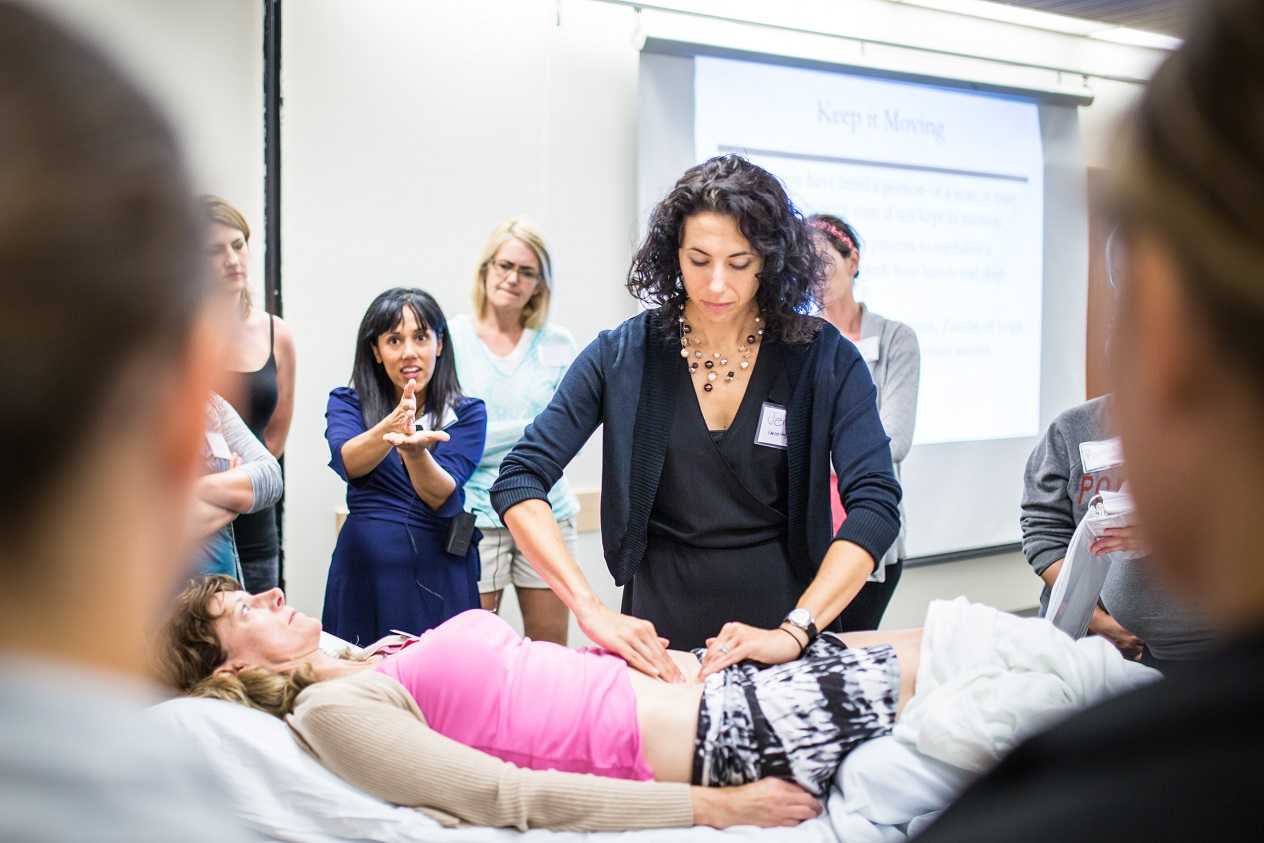Holly Herman, co-founder of the Herman & Wallace Pelvic Rehabilitation Institute, has just returned from Saudi Arabia, where she educated the first class of 34 female physical therapists in the art and science of women's health physical therapy.
She was accompanied by esteemed colleague and well-known educator Fatima Hakeem. Together they created 11 days of intensive-training education, which they taught over a 14 day period. Topics instructed included pregnancy and postpartum, female pelvic floor dysfunction and female sexual health. Participants earned a Advanced Clinical Diploma in Pelvic Floor Treatment from the Saudi Physical Therapy Association (SPTA), as well as CAPA certificates through the Institute.
Holly has already shared pictures of herself and new friends covered from head to toe in a traditional abaya, a garment that was required for modesty. She also had the opportunity to travel around the country and see historical landmarks and ride camels in the desert!
An amazing graduation ceremony took place this past week and the ceremony was graced by many high-ranking officials as well as the country's Princess, who made a pointed effort to thank Holly and Fatima for sharing their knowledge and wisdom so that many women and their families can benefit from improvements made in the lives of women in her country. Holly and the Institute were presented with 50lb glass plaque in a felt-lined mahogany box for contributing to women's health in the region. In light of this advanced and specialized training program, Saudi Arabia has created a Women's Health Section of the SPTA. At the ceremony, the Princess granted a million riyals ($375,000) to the new Women's Health Section. Herman & Wallace has committed to continuing to work with our partners, Rafeef Al-Juraifani PT, MSc and Othman Alkassabi, PT, PGD, MBA to bring continuing education to this region of the world.
It is the goal of these students to all be certified PTPC practitioners. Herman & Wallace are currently in the phase of the project that requires defining the role of the pelvic rehab therapist. Please check your e-mail for this invitation to complete the survey or click here.
In September, Holly and Fatima will be traveling to Dubai to teach a similar seminar in the United Arab Emirates.
Nocturia, defined by the International Continence Society(ICS) as waking one or more times at night to void, is a condition that has been correlated with severe health risks and mortality. Recent research brings this issue to the forefront and provides us with knowledge that we can share with our patients, providers, and perhaps with our loved ones. (Nocturnal enuresis, not to be confused with nocturia, is voiding while sleeping.)
Vaughan et al. examined the association between falls and nocturia in a "...racially diverse, community-based sample..." of 692 older men and women. The authors found that having nocturia 3 or more times/night increased the risk of falls 28% over a 3 year period. Patients in this study who were classified as "fallers" were also more likely to be over 85 years of age, be female, have a diagnosis of diabetes, use diuretics, and they were found to have an abnormally slow gait speed. A longitudinal study from Japan reports that nearly half of their 784 community-based participants reported nocturia occurring 2 or more times/night. The authors of this study concluded that over a 5 year observation period, elderly individuals with nocturia were at greater risk for fracture and mortality. It is well reported within the orthopedic and rehabilitation literature that falls in the elderly can lead to significant mortality, morbidity, and inability to live independently.
The association of nocturia and mortality was also documented in a United States population study and was reported to have a dose-response relationship (the more episodes of nocturia/evening increased the risk of mortality.) Data from the Third National Health and Nutrition Examination Survey was utilized to demonstrate this association. In 15,988 men and women at or above age 20, the incidence of nocturia was 15.5% in men and 20.9% in women. The authors suggest that the loss of sleep leading to other comorbid conditions is a likely cause of the relationship between night voids and mortality.
If nocturia is correlated to poorer health and increased risk of mortality, what can be done to alleviate it? The ICS standardisation report on terminology for nocturia describes the importance of first screening for the condition. A screen can include detailed history taking and the use of a bladder diary. Advice relating to decreasing caffeine, alcohol intake or any food/fluid intake near bedtime may alleviate the condition. A patient also needs to discuss the issue with a medical provider as a sleep disorder, diabetes, bladder storage issue, kidney or cardiac condition could be the causative factor in a patient's frequent night voids.
As Pelvic Rehabilitation Institute faculty Ramona Horton (who I can thank for sending me the above articles) communicated to me, the information in the above articles make sense as it corresponds to what we observe in the clinic and in the community. Having the information appear in the literature validates these observations and allows us to describe to patients that nocturia is more than an annoyance- it's harmful to one's health. Pelvic rehabilitation providers can educate patients in behavioral strategies and can assist the provider in determining the best plan of care for the patient based on a thorough evaluation.
As reported in the American Journal of Clinical Dermatology, body piercings in general can cause complications of infection, bleeding, contact dermatitis, scarring, or nerve damage. Genital piercings carry a risk of infertility following significant infection, urethral obstruction, priapism or fistula formation in males. In anarticle about the care of young women who have genital piercings, Young and colleagues report that young women who have complications from a genital piercing often seek help from the piercer or from the internet rather than from a medical provider. The authors also point out that there are many assumptions written in the literature (such as high rates of loss of sexual response or high rates of sexually transmitted diseases) that is not based in scientific evidence. The aim of the latter article is to utilize descriptive evidence to establish helpful care options for providers. In order to obtain data, surveys were completed by 240 females with genital piercings as well as health care providers who offered care to women with genital piercings.
Two qualitative research studies are described in the article and include reasons for a female acquiring a genital piercing. These reasons range from sexual enhancement to psychological healing from events such as rape. "These deeply personal events produce feelings of loss that often predispose an individual to reclaim that part of the body..." In one of the studies with 35 females who had genital piercings, some of the issues they faced as complications included local sensitivity, skin irritation, sexual problems, infection, scarring, and UTI. In the research by Young et al. that appears in the Journal of the American Academy of Nurse Practitioners the results showed that most of the 240 women were Caucasian, heterosexual, married, in excellent health, college-educated women who declared salaries around 45,000/year. The researchers were surprised to learn that over half of the women with genital piercings reported abuse, more than one third had reported some type of forced sexual experience against their will, and most had been told that they suffered from depression.
Although many of the women reported that they attended to skin care near the genital piercing, there was little mention of limitation of physical activities due to the piercing including vigorous fitness activities. The women who completed the survey had very positive feelings about the piercing, and most chose a piercing at the clitoral hood. When the participants were asked about the response from health care providers towards the genital piercing, many described that the provider was shocked and often told the patient that cleanliness was very important and at times to remove the jewelry. Some patients decided to take the jewelry out prior to an annual exam to avoid judgement. Of the 60 health care providers who responded to the survey, many of the comments to the open-ended questions were related to labor and delivery, many of the comments were positive, and some of the comments were very judgmental towards the character of the patient who had genital piercings.
Regarding the "implications for nurse practitioners" in this article, the authors suggest that the health care provider be responsive to women about the genital piercing. In other words, acknowledge that it is there in a non-judgmental manner, and inquire about it if there are concerns. It is also suggested that the provider collaborate with the patient if removal of the jewelry seems necessary. It is very interesting that in the survey respondents who were pregnant with a piercing, over half of them did not remove the jewelry for labor and delivery, and no complications have been noted in the literature regarding labor and genital piercings according to the authors.
As always, we want to ask ourselves if and how this information can relate to our role in providing pelvic rehabilitation care. If a patient presents for an examination, we can follow the recommendation in this article to "be responsive" and acknowledge the piercing. It should not need to be removed for an examination and/or treatment. Could the piercing itself be a possible source of scar tissue, nerve irritation, tender point, or hypersensitivity? That seems entirely possible, and this possibility can be explored with the patient and with the referring provider as appropriate. Because genital piercings (and piercings in general) are more popular, we may have questions posed to us by patients, colleagues, or by a patient's family members. Awareness of this descriptive data may allow us to give a more thoughtful answer, and to feel more confident in our approach when examining or treating a patient who has a genital piercing.
As reported in Physical Therapy, the tendency to catastrophize may not be a stable one, as women demonstrated measurable changes across time during pregnancy and during the postpartum period. Pain catastrophizing, as described in this article, is "...an exaggerated negative orientation toward noxious stimuli." In this research, 242 women were assessed using the Pain Catastrophizing Scale during weeks 19-21, weeks 34-37, and at 6 months postpartum. You can learn more about the Scale by clickinghere. The Disability Rating Index was also utilized at 6 months postpartum to assess physical ability.
What the researchers found is that most of the women (57.9% ) did not catastrophize during any of the test scoring, while 10.3% reported catastrophizing during all test events. The remaining number of women had variable test scores towards pain catastrophizing, and they also reported higher levels of postpartum lumbopelvic pain as well as higher levels of activity restriction when compared to the women who did not catastrophize. Lumbopelvic pain included self-reported pain in the low back, anterior or posterior pelvis.
The authors point out that other research has correlated catastrophizing about labor with increased pain intensity during labor, and decreased social functioning and physical ability in the postpartum period. While other studies mentioned have reported a consistent response towards catastrophizing, this study identifies variation in catastrophizing that occurs for some women over the course of pregnancy.
Regarding the clinical implications of this research, the authors conclude that the study design does not allow for prediction of disability based on catastrophizing scores. It may be useful, however, to identify women who are catastrophizing their pain during pregnancy so that interventions may be offered. The authors of this study refer to interventions such as cognitive behavioral therapy, education, exercise, and treatment related to physical activity as ways to minimize physical disability. Certainly with the challenges a new mother faces, decreasing any potential physical limitations and improving social functioning would help in encouraging a healthier postpartum period.
Pelvic inflammatory disease (PID), involves inflammation and infection of the upper female genital tract, and according to Dr. Jonathon Ross, Professor of Sexual Health and HIV, is associated with infertility, ectopic pregnancy, abscess formation, and with pelvic pain. PID one of the most common infections in women of child-bearing age, and PID is the most common gynecological reason for admission to hospital in the US. Statistics from this systematic review (you can access the full article here) include that about 20% of women with PID develop infertility, 40% develop chronic pelvic pain, and 1% will have an ectopic pregnancy. Risk factors for acquiring pelvic inflammatory disease include young age, reduced socioeconomic status, and new sexual partner. It is also not uncommon for a patient to have a recurrence of PID, and this increases the risk of infertility significantly.
Dr. Ross cites a case control study that demonstrates that a delay in care of 3 days can significantly increase the risk of infertility in women, therefore it is very important to screen the patient who may be at risk for pelvic inflammatory disease. The most important factor to consider is whether or not the patient (who may be seeing you for her pelvic pain) has been seen by a medical provider. In the medical office, the patient may have testing completed to rule out sexually transmitted diseases (STD's), or have a pelvic examination done to check for typical tenderness in the pelvic organs. Unfortunately, pelvic inflammatory disease can be a "silent" disease, according to the literature, so it is important to keep in mind that even if a patient has seen a medical provider, a return visit may be warranted if the patient's condition is worsening, is failing to improve, or if you learn more information about the patient's history that makes you more concerned about the possibility of PID. This might include finding out that the patient does have a history of an STD, has multiple partners, or has had a recent history of a change in sexual partners.More obvious signs and symptoms of pelvic inflammatory disease according to the Center for Disease Controlcan include fever, vaginal discharge with odor, painful intercourse, painful urination, irregular periods, and possibly right upper quadrant abdominal pain.
The fact that pelvic inflammatory disease can have such profound consequences on a woman's health should keep the pelvic rehabilitation provider alert to the possibility of such infections in our patients. While we rely upon the medical provider to screen for such disease, we are responsible to listen well, ask relevant questions (often asking them again on repeat visits) so that we can get a patient to medical evaluation quickly if we suspect that a patient could have an active infection requiring medical intervention.
Over the years, I have met many patients who choose not to wear underwear due to perineal irritation, severe pelvic pain, or perhaps recurrent infections. Patients who have hypersensitive scars on the abdomen, bladder pain, allergies or reactions to fabric cleaners, or who simply cannot wear underwear comfortably now have another option that is easily available. Check out COMMANDOS, a single-use cotton patch that sticks to the inside of your clothing so that the only thing touching the vulvar area is a very soft, non-chafing fabric. These can be worn everyday, as a substitute for underwear, or to replace going completely commando because the seams of clothing can rub and irritate.
Check out the website with the above link for detailed information about product materials used (great attention is given to the materials in the adhesive, for example) as well as for the variety of testimonials from happy customers. From patients with pelvic pain to fitness professionals wearing exercise pants all day to equestrians wearing riding pants, people seem to really be grateful to avoid the irritation of thongs or the added bulk of underwear that may not always stay in place.
Keep this product in mind for your patients when you are discussing the functional limitations posed by pelvic pain including restrictions in clothing choices and potential for irritation from seams in clothing. COMMANDOS wishes to support pelvic rehabilitation providers by giving a discount for you and your patients. You or your patients can enter Promo Code EVYMED for a 15% discount. A 4-pack assortment costs $10 plus shipping , and packs of 8 are $16 (or $18 for organic cotton patches.) Try them out yourself, order a pack for the clinic to show patients, or give them away as door prizes at your next staff meeting or community presentation! And be sure to give COMMANDOS some feedback if you find the product is helpful for your patients.
What is the role of the pelvic rehabilitation provider when a patient fails to follow-through on your recommendations? This issue is addressed in the medical literature, particularly for compliance with medications or medical office follow-up appointments, and it is in the medical literature where we can find a very useful articleabout the subject. Dr. Kleinsinger, MD, writes from a clinically practical point of view, and his suggestions for dialog and re-framing a patient's compliance issues can be put into use immediately. You can access the full article here.
The term "non-compliance" has been previously criticized as sounding judgmental towards a patient who is not following orders from a physician. The term "non-adherence" has been suggested as an alternative and is one that you may see in the research as well. Dr. Kleinsinger states that "non-compliance" can be utilized as long as the patient's plan of care involves both the provider and the patient in decision-making. In pelvic rehabilitation, we may not be dealing with life-threatening issues such as a patient not taking cardiac medications, however, we are required to utilize a patient's rehabilitation resources wisely and to continuously assess the response that our treatment has on the patient's health. This is challenging when a patient chooses not to complete self-care, avoid injurious activities, or take part in an instructed home program.
The suggestions in this article are directed primarily towards medication compliance, yet the principles of communication and shared decision-making can be immediately applied to the rehab clinic as well. Dr. Kleinsinger states that trust is paramount in encouraging compliance, and the clinician must recognize the power differential between the patient and the provider. Following are some guidelines adapted from the article:
1. Pose your questions in a non-judmental manner and with a problem-solving approach. Example: "I see that you have not been completing your exercises properly. Are you having difficulty with the written program I gave you?"
2. Ensure that there is a common understanding regarding the importance of the problem, the available and effective treatments, and the risks of under-treating the condition. Example: "If your body is not moved in these first weeks after surgery, you may develop a significant loss of motion that can be very painful to recover. Do you have concerns or questions for me about your treatment?"
3. Develop a shared understanding that compliance is critical to improvement.Example: "It seems that what we are trying is not working for you, and we both want you to benefit from rehabilitation. What do you think will be more helpful?"
4. Build a more effective therapeutic partnership with your patient by being open, non-accusatory, and focused on problem-solving. Example: "What could I do differently to help you? What obstacles are we facing? How could we tackle this more effectively?"
Dr. Kleinsinger offers further, useful suggestions towards effective communication, such as using physical mirroring, using "I" statements, and reinforcing that the patient can take positive action towards health. Choosing one issue at a time or asking family or friends to help out can also be meaningful for the patient. This article offers further approaches to specific causes of non-compliant behavior that you might find beneficial for your practice. Perhaps this article could be a simple tool (for a complex problem) to share with colleagues at a meeting or inservice. The author includes a checklist of tools for working with a non-compliant patient that may also be of use. He emphasizes the importance of using non-judgmental, open language when establishing a trusting relationship with the patient. It is difficult to "listen" to ourselves when we dialog with patients, yet if you can pause to think about how you are framing your discussions, it may be helpful for maximizing patient compliance. Another strategy that I have found useful is to seek out those around you who are very effective at carrying out the behaviors described in this article and modeling those behaviors. If we based our need for improved communication on all the available relationship self-help books, we can be assured that maximizing our use of communication in the clinic and in our personal lives is something that we will be refining for years to come.
As we head into the New Year, we commonly reflect on the past year and plan for the next 12 months. I wanted to share with you a tool that I have found to be useful not only in my personal life, but also in assisting patients with choices. This is a tool that I first read about in a book about neurolinguistic programming, and one that I understand many life coaches use when assisting people who want to assess various aspects of self or of life categories.
First, make a large circle on a piece of paper. Then divide it into "pie pieces" and label each piece of pie with a category. For example, if you wanted to get a sense of your personal satisfaction with your life, you might choose: spiritual practice, fitness, primary relationship, work, finances, and home improvement. List numbers from the center of the circle outward along the lines separating the category, you can use any range of numbers such as 1-5 or 0-10. Then score your rating for each category with the higher number being a positive rating. Let's say you self-score at least an 8 on all categories except for finances. If that is the case, you can then list a few tangible goals that relate to financial health with dates for achieving those goals. This type of wheel can be completed very quickly and in my experience it does not take much thought to score your sense of happiness within the various categories. If you focused this wheel on work/career, you might label the pieces as various aspects of evaluation, treatment, perhaps body parts, or even categories such as managerial tasks versus documentation. We are often balancing so many domains in our life that it is challenging to stay at a "10" with any one category for long; we are often giving of our energies to patients, to employers, to our families and children, and this leaves little time for our own self-care.
Many patients who present to our clinics our facing similar challenges. You may have met the patient who reports he or she is "falling apart" and does not know where to start, or who suffers from pain that limits sleep, work, and self-care, making it difficult to complete the 3 exercises we instructed last session. Perhaps your patient can be given a wheel of life assignment for a home activity, or it can be completed in the clinic. Once areas of dissatisfaction are identified, the patient can set goals towards improvement. If the wheel was designed to represent various environments that support or impair a patient's healing process, perhaps it could be sorted out that the work environment is where the patient feels resistance to follow-through with therapy concepts. This would allow you to help develop strategies towards improving that work environment in relation to rehab (such as an ergonomic eval, for example.) It may give another patient the opportunity to identify that her primary relationship is really struggling, therefore she does not truly want to return to intercourse with her partner due to these issues. If your home program of self-stretching or breathing, etc, is aligned towards physical intimacy with her partner, she may sabotage her home program and fail to progress. If she is able to make these connections as part of her pelvic rehabilitation, perhaps she will recognize that she wants to attend some counseling before continuing the physical rehabilitation process. My example is hypothetical, yet most of you could share similar stories about patients who are either overwhelmed by their life, or who are subconsciously resistant to your best efforts at rehabilitation because they are struggling with other more important issues.
I hope that you find this exercise useful in your own life. Sometimes I simply share the idea verbally with a patient, friend, or colleague and it is simple enough that the person can make a mental note to try it at a later time. I have found it very valuable to save the wheels in a notebook, re-assess and then see where progress has been made. Of course, the progress is usually made because goals were identified and efforts were made towards completing the goals. On behalf of the Herman & Wallace Pelvic Rehabilitation Institute, I wish you a very Happy New Year, and happy goal setting as well.
Can you list the three components of the female athlete triad? In an article published in a physical therapy sports journal 205 physical therapists were asked this same question, and only 21% of the therapists could list all components. These components are disordered eating (not to be confused with "eating disorder" because that is a more narrow description), menstrual dysfunction, and lowered bone density. The study further describes the strategies that surveyed physical therapists utilize to treat and/or prevent the female athlete triad.
Pantano, the author of this study, points out that "...therapists must be responsible for recognizing, treating and preventing the female athlete triad." Nearly 25% of the respondents surveyed described involvement in treatment via education (to include the patient, family, physician, or coach) or referral of the athlete, screening of the athlete, and nearly 50% reported efforts at prevention of the disorder. It is interesting to note that the surveys were sent to members of either the Orthopedic or the Sports Physical Therapy Specialty groups of the American Physical Therapy Association (APTA), and many of the PT's who participated in the study were also certified in athletic training and interfaced often with female athletes.
Regardless of how often we work with athletes, it is crucial for pelvic rehabilitation providers to be globally aware of the signs, risks, and treatments for female athlete triad. In the National Athletic Trainers' Association (NATA) position statement on the management of disordered eating in athletes, it is pointed out that disordered eating (DE) can not only impair health and function, but DE can be fatal. This article that you can access in full text contains excellent screening tools, advice for referrals to nutrition experts, and information about current treatment.
At a minimum, we must be aware that adolescent females can suffer from disordered eating that leads to poor energy availability in the body, with increased risk of menstrual dysfunction, and decreased bone density and risk for fractures in athletes. Knowing how to ask the right questions, provide education and communicate with a team of providers can improve the lives of athletes who are at risk for female athlete triad symptoms. The NATA guidelines suggest that female athletes should be evaluated within the first 3 months of amenorrhea so that aggressive screening and treatment can be implemented. It is common for an athlete to have one or two of the components, such as disordered eating and amenorrhea without bone loss. The guidelines also point out that males can suffer equally from disordered eating and a high suspicion should be in place for male athletes who are reluctant to discuss their eating patterns, regardless of the sport in which he participates.
Most of us, regardless of treatment setting, can make use of this information to maximize our awareness of the profound affects that athletics and improper diet can have on our female patients. Opportunities are available in our communities as well as in the clinical setting for educating others about the risks and about the available treatments.
The Bladder and Bowel Foundation (B&BF), a non-profit organization in the UK, has recently published an educational brochure for teenagers that teaches them about the pelvic floor muscles. The publication was also written in part by teenagers, and it has a look and feel that is appropriately "younger." If you click here, and then scroll through the announcement about the leaflet, you can view it on-line. You will note that many topics are covered, such as the where and why of pelvic floor muscles, and even the how to contract and exercise them. Conditions or habits that can interfere with pelvic floor health are described, including childbirth, smoking, coughing, and underactive abdominal and pelvic muscles.
Teenagers are struggling with pelvic pain, bladder, bowel, and sexual dysfunctions, and may feel uncertain about with whom they can discuss the issues. We know from the adult pelvic floor literature that in general, physicians don't ask and the patient is embarrassed to tell. What would make a teenager any more likely to share such private information? Teenagers may experience painful sexual encounters, bowel issues such as constipation or fecal incontinence, and bladder issues including urgency, pain, or leakage. (Have you noticed how many teens stop at Starbucks on the way to school now? Who is educating them about bladder irritants?) Athletes may also have increased risk of leakage, especially when engaged in high-impact sports.
I have often wondered how we can better impact the health of children and young adults if we discussed their pelvic floor as well as bowel, bladder, and sexual health beginning at younger ages. In this country, we certainly come up against the controversy of discussing the pelvic floor as it relates to sexual health, as well as the challenge of speaking about bodily functions that are not typically discussed. It may not be possible at this time to have pelvic floor education taught throughout middle and high schools, but it may be possible for pelvic rehab providers to improve the knowledge of parents and teens in our own communities. Perhaps offering a program at a local community center, with a session for adults and one just for teenagers would work. To better inform the parents, each adult could be given a detailed outline of what will and will not be included in the teen session. Better yet, the adults could be instructed in the same information so that the chances of dialog between parent and child may be more likely.
You may find the new teen pelvic floor resource useful in designing a brochure or a handout that could be offered in your own clinic or at a local event. As we continue to educate our colleagues, referral sources, and patients about pelvic floor health and function, we may be able to broaden the age base and improve the help that is offered to teenagers.
By accepting you will be accessing a service provided by a third-party external to https://hermanwallace.com/















































